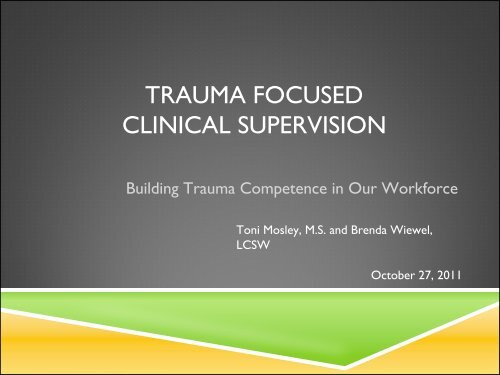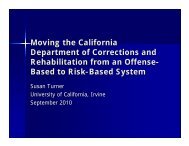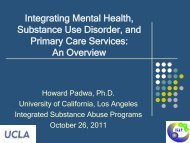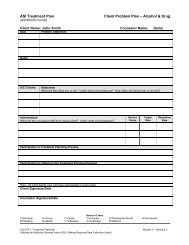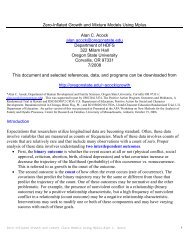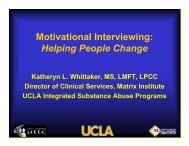Trauma Focused Clinical Supervision and Workforce Development
Trauma Focused Clinical Supervision and Workforce Development
Trauma Focused Clinical Supervision and Workforce Development
Create successful ePaper yourself
Turn your PDF publications into a flip-book with our unique Google optimized e-Paper software.
TRAUMA FOCUSED<br />
CLINICAL SUPERVISION<br />
Building <strong>Trauma</strong> Competence in Our <strong>Workforce</strong><br />
Toni Mosley, M.S. <strong>and</strong> Brenda Wiewel,<br />
LCSW<br />
October 27, 2011
WORKSHOP OBJECTIVES<br />
1. Define trauma informed supervision <strong>and</strong> goals<br />
2. Review the impact of trauma on the treatment process<br />
as it relates to clients <strong>and</strong> clinicians<br />
3. Learn how to help clinicians take the trauma into<br />
account, while maintaining their own balance through<br />
self-caretaking<br />
4. Explore how to address vicarious trauma <strong>and</strong> trauma<br />
triggers for staff to improve staff functioning <strong>and</strong> prevent<br />
burnout
TRAUMA IMPACT<br />
ON ROLES AND RELATIONSHIPS<br />
Parallel process<br />
Client/Therapist<br />
Therapist/<strong>Clinical</strong> Supervisor<br />
Importance of relational issues<br />
Awareness <strong>and</strong> incorporation of trauma impact
TRAUMA: GENERAL DEFINITION<br />
An extreme stress that overwhelms a<br />
person’s ability to cope -- a normal<br />
response to an abnormal event.
HUMAN BIOLOGY<br />
Our body responds automatically to stressful<br />
situations, especially those that are perceived as a<br />
survival threat where we feel fear, horror, <strong>and</strong><br />
helplessness<br />
The result is an impact on our body’s nervous system<br />
<strong>and</strong> brain chemistry<br />
We may then negatively label our reaction, leading to<br />
self-blame/shame
UNDERSTANDING THE BRAIN<br />
1. External stimulus<br />
perceived by<br />
prefrontal cortex<br />
2. Hormones sent to<br />
amygdala for flight,<br />
fight, or freeze<br />
3. Survival memories<br />
imprinted in basil<br />
forebrain<br />
4. Bypasses cerebral<br />
cortex where<br />
logical thinking<br />
occurs- so need to<br />
reprocess through<br />
cerebral cortex to<br />
put all the pieces<br />
together
TWO PART NERVOUS SYSTEM<br />
Part 1: Sympathetic<br />
Prepares for action by ramping us<br />
up, energizes or activates body<br />
Part 2: Parasympathtic<br />
Prepares for rest by relaxing<br />
body<br />
This part gets stuck on if external<br />
risk or threat from stress is high<br />
We need to learn how to reduce this<br />
automatic activation.<br />
This part lies dormant when part<br />
1 is stuck on “ON”. We need to<br />
learn how to turn back on the<br />
rest/relaxation response within<br />
body to rebalance ourselves.
RESILIENT ZONE<br />
Each body has a resilient zone where we are able to function best<br />
in all areas<br />
Stressful events (too much/too fast/too long) can bump us out of<br />
our resilient zone<br />
Stuck on LOW: depression, fatigue, numb<br />
Stuck on HIGH: hyper-vigilant, anxious, rage<br />
Can cycle between low <strong>and</strong> high out of resilient zone
PRINCIPLES FOR TRAUMA-INFORMED TREATMENT<br />
Take the trauma into account.<br />
Avoid triggering trauma reactions <strong>and</strong>/or<br />
traumatizing the individual.<br />
Adjust the behavior of clinicians <strong>and</strong> the<br />
organization to support the individuals’ coping<br />
capacity<br />
Allow survivors to manage their trauma<br />
symptoms successfully so that they are able to<br />
access, retain, <strong>and</strong> benefit from the services.<br />
(Harris <strong>and</strong> Fallot)
CORE CONCEPTS FOR TRAUMA-INFORMED<br />
TREATMENT<br />
• <strong>Trauma</strong>-informed services are based on an<br />
underst<strong>and</strong>ing of the impact of violence <strong>and</strong><br />
victimization<br />
• All treatment for substance use/co-occurring<br />
disorders should be trauma-informed<br />
Institute for Health <strong>and</strong> Recovery
CLINICAL SKILLS FOR TRAUMA-INFORMED<br />
TREATMENT<br />
See trauma as a defining <strong>and</strong> organizing<br />
experience that can shape a survivor’s sense of<br />
self <strong>and</strong> others<br />
Develop a self-care plan (as a helper) to avoid<br />
compassion fatigue <strong>and</strong> burnout.<br />
Establish clinical intervention strategies that<br />
respond to the individual’s experience of<br />
trauma
STRATEGIES FOR TRAUMA-INFORMED TREATMENT<br />
Clinician works with client to:<br />
get <strong>and</strong> stay safe<br />
separate here <strong>and</strong> now from there <strong>and</strong> then<br />
stay in control of process<br />
recognize <strong>and</strong> underst<strong>and</strong> trauma triggers<br />
use safe coping skills to manage reactions<br />
support emotional literacy development<br />
recognize <strong>and</strong> use internal strengths<br />
build <strong>and</strong> use external support systems<br />
THESE ARE THE TREATMENT PLAN GOALS!
FAILURE TO UNDERSTAND & ADDRESS TRAUMA<br />
CAN LEAD TO:<br />
1. Failure to engage in treatment services (Farley, 2004)<br />
2. Increase in symptoms (eating disorders, self-harm)<br />
3. Increase in management problems<br />
4. Retraumatization (Harris <strong>and</strong> Fallot, 2001)<br />
5. Increase in relapse<br />
6. Withdrawal from service relationship<br />
7. Poor treatment outcomes (Easton et al 2000; Ouimette et al 1999)<br />
Institute for Health <strong>and</strong> Recovery
UNIVERSAL PRECAUTION<br />
A client should not<br />
have to disclose<br />
trauma to receive<br />
trauma-informed<br />
services—treat<br />
everyone as a potential<br />
trauma survivor.<br />
Institute for Health <strong>and</strong> Recovery
CLINICAL IMPLICATIONS OF<br />
TRAUMA IN TREATMENT<br />
FOCUS ON THE CLIENT
CORE ISSUES THAT IMPACT A CLIENT<br />
WHAT IS THE EMPHASIS AREA FOR THE CLIENT<br />
WHAT ARE THE IMPLICATIONS FOR TREATMENT<br />
Relationships<br />
Cultural Context<br />
Cognitive/Affective Coping<br />
Life Experience/<strong>Trauma</strong><br />
Gender Role<br />
Developed by Toni Mosley M.S. (2007)
SAFETY<br />
Safety is an enormous therapeutic task for many clients<br />
<br />
<br />
<br />
<br />
Treatment progress can’t occur unless a client feels<br />
safe<br />
How does the client/clinician define safety<br />
What are barriers to client feeling safe<br />
How can the clinician intervene to improve physical<br />
<strong>and</strong> emotional safety
TRIGGERS<br />
In AOD, trigger refers to people, objects, feelings,<br />
times that cause cravings<br />
In trauma, trigger refers to people, objects, feelings,<br />
times that cause trauma memories/PTSD symptoms<br />
Cycle of trigger-trauma reaction can be emotional,<br />
behavioral, or attitudinal <strong>and</strong> feels overwhelming<br />
Clients may need help to manage the symptoms <strong>and</strong><br />
triggers
KEY TRAUMA SYMPTOMS<br />
Dysregulation of emotions<br />
High level of anxiety<br />
Dissociation<br />
Lack of support to label <strong>and</strong> identify experience
CLINICAL IMPLICATIONS OF<br />
TRAUMA IN TREATMENT<br />
FOCUS ON THE CLINICIAN
KEYS TO DEVELOPING THERAPEUTIC<br />
RELATIONSHIPS WITH COD CLIENTS<br />
1. Use therapeutic alliance to engage client in treatment<br />
2. Maintain a recovery perspective<br />
3. Manage counter transference<br />
4. Monitor psychiatric symptoms<br />
5. Use appropriate <strong>and</strong> empathic counseling<br />
6. Employ culturally appropriate methods<br />
7. Increase structure <strong>and</strong> support
10 STRATEGIES TO SUPPORT<br />
CLIENTS<br />
1. Listen more than talk<br />
2. Give permission to speak<br />
3. Respond to the pain you hear the client convey<br />
4. Support emotional literacy<br />
5. Help client underst<strong>and</strong> role <strong>and</strong> use of grounding tools
10 KEY STRATEGIES TO SUPPORT CLIENTS<br />
6. Help client identify individualized coping tools<br />
7. Check for client’s readiness for change<br />
8. Support safety plan development <strong>and</strong> use<br />
9. Look for link to trauma experience in survival, protective,<br />
or defensive behaviors that interfere with relationships<br />
10. Never underestimate the power of caring
RELATIONAL BARRIERS<br />
Inability to connect with self<br />
Problems with parental bond<br />
Difficulty connecting with others
OVERCOMING RELATIONAL BARRIERS DURING<br />
TREATMENT PROCESS<br />
Clinician is the tool of his/her trade<br />
Create a holding environment with safety<br />
Focus on relationship difficulties<br />
Tolerate client’s level of anxiety <strong>and</strong> emotion<br />
Build capacity for emotional processing an insight
BASIC CONCEPTS FOR CLINICIANS TO LEARN<br />
<br />
<br />
<br />
<br />
<br />
Client choice <strong>and</strong> self-control: client must be a full partner in<br />
deciding on goals, feel validated regarding experiences, <strong>and</strong> be<br />
given info/options to help improve decisions <strong>and</strong> self-care<br />
Need to recognize trauma triggers/reactions <strong>and</strong> help client<br />
feel supported<br />
Importance of responding to immediate practical needs,<br />
especially safety<br />
Clients have ability to develop a healthy compassionate<br />
resource within themselves<br />
Clients can learn to listen to their bodies, underst<strong>and</strong> their<br />
feelings or symptoms, <strong>and</strong> express themselves
CLINICAL IMPLICATIONS OF<br />
TRAUMA IN TREATMENT<br />
FOCUS ON THE CLINICAL SUPERVISOR
BOUNDARIES<br />
<br />
Maintain strong boundary expectations for clinicians<br />
Train <strong>and</strong> educate about expressing their own<br />
feelings <strong>and</strong> reactions outside of the client- clinician<br />
relationship safely <strong>and</strong> appropriately<br />
Help clinicians learn <strong>and</strong> practice safe <strong>and</strong><br />
professional options for how to respond to<br />
aggressive, agitated, overly clingy/dependent, or<br />
isolative behaviors in clients<br />
Clarify how boundary violations harm clients
TRAUMA TRIGGERS FOR CLINICIANS<br />
Create a safe supervisory environment for clinicians to<br />
identify <strong>and</strong> communicate as needed/desired about their own<br />
trigger reactions<br />
Help clinicians underst<strong>and</strong> their own reactions in relation to<br />
their personal history<br />
Teach clinicians to take responsibility to protect clients<br />
from their own overreactions or to re-engage clients<br />
afterwards
PRACTICAL STRATEGIES TO HELP CLINICIANS<br />
ACCOMPLISH TRAUMA-INFORMED TREATMENT GOALS<br />
Evaluate clinician strengths, capacity for self-awareness,<br />
tolerance for strong emotions, <strong>and</strong> listening skills<br />
Be patient<br />
Use broken record technique to teach key concepts<br />
Carefully match clinicians to clients, considering trauma<br />
issues <strong>and</strong> vulnerabilities on both sides<br />
Maintain positive curious attitude that there is always a<br />
reason behind behavior to discover <strong>and</strong> learn from
KEY AREAS FOR CLINICAL SUPERVISION<br />
Client/Clinician emotional regulation or<br />
disregulation (overloaded=stuck on “on” or<br />
shut down=stuck on “off”<br />
Immediate practical needs (danger in<br />
environment)
ATTENTION TO CLINICIAN PROCESSES<br />
Attend to Negative Countertransference:<br />
1. Harsh confrontation<br />
2. Inability to address accountability<br />
3. Becoming a victim<br />
4. Power struggles<br />
5. Allowing clients to be scape-goated in group settings
ATTENTION TO CLINICIAN PROCESSES<br />
<br />
<br />
<br />
<br />
<br />
<br />
Building an alliance<br />
Compassion for client’s experience<br />
Using various <strong>and</strong> assigned coping skills<br />
Providing an environment of control<br />
Modeling <strong>and</strong> meeting clients halfway<br />
Open to obtain feedback
CLINICAL SUPERVISION QUESTIONS<br />
Identify 1 concern you have about your client <strong>and</strong> how this<br />
relates to a strength they bring.<br />
What is hardest for you personally when you interact with<br />
your client Is there a parallel process here<br />
How is the client’s behavior related to their trauma triggers<br />
<strong>and</strong> reactions<br />
How is the client’s behavior triggering something for you<br />
(the clinician) personally<br />
How am I (as the supervisor) reacting to this clinician Is<br />
there a parallel process here <strong>and</strong> is it trauma related<br />
At what points might you have w<strong>and</strong>ered away from your<br />
clinician role
SKILL PRACTICE<br />
Please join into groups of three, pick one person to play the client, clinical, <strong>and</strong> clinical supervisor<br />
1.Client will choose an issue (significant grief/loss, rape,<br />
domestic violence) <strong>and</strong> discuss what they need to do to take<br />
care of themselves<br />
2.Clinician will then share how this might affect them <strong>and</strong><br />
what they need to do to take care of themselves with the<br />
clinical supervisor<br />
3.<strong>Clinical</strong> supervisor will then discuss what they might do<br />
with what they heard.


